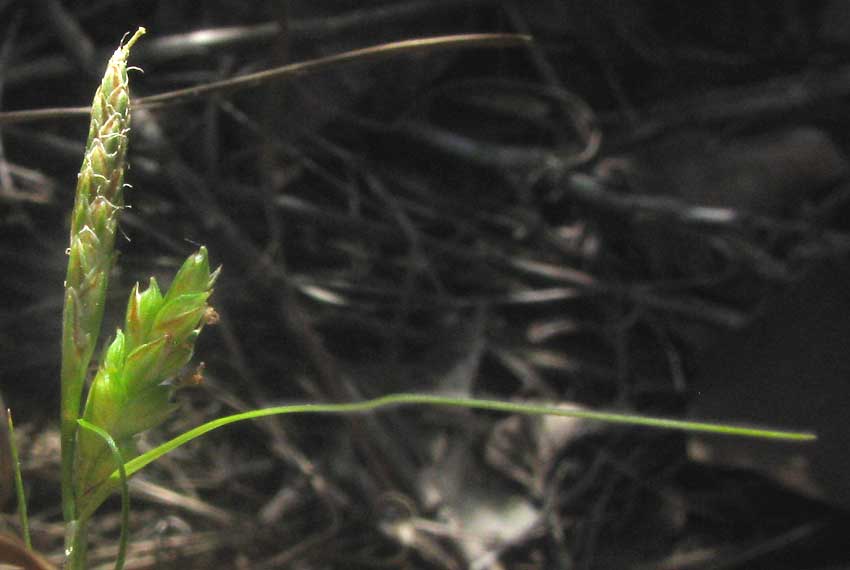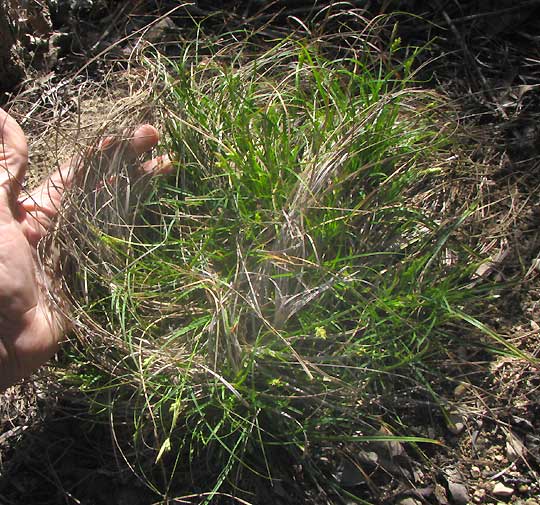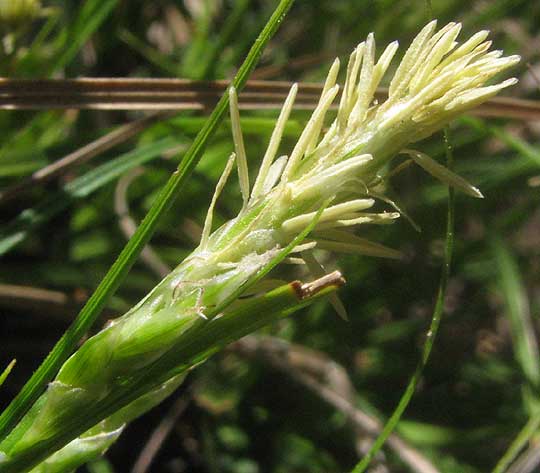Excerpts from Jim Conrad's
Naturalist Newsletter

from the March 17, 2013 Newsletter issued from the valley of the Dry Frio River in northern Uvalde County, southwestern Texas, on the southern border of the Edwards Plateau; elevation ~1750m (~5750 ft); N29.62°, W99.86°; USA
CEDAR SEDGE
Hiking beside the little Dry Frio River, across a low cobblestone terrace sparsely inhabited with flash-flood-shattered Sycamores, I was about to give up on finding anything new flowering when I came upon a hat-size clump of wiry looking grass, or something that looked like grass, bearing flowers at the tips of some its stems. The unspectacular tuft is shown below:

A quick look at the flowers let me know that we weren't dealing with a grass, but rather a sedge in the Sedge Family, the Cyperaceae. You can see one of its very un-grasslike flower clusters at the top of this page.
In that picture the vertical spike at the far left consists of only male flowers while the smaller, thicker spike sprouting from the male spike's base bears only female flowers. The long, slender thing parallel with the bottom of the picture is a bract arising at the spikes' base. It's included in the picture because often the length of the bract relative to the lengths of the spikes is important in identifying sedges to species level.
And sedge identification can be hard, mainly because there are so many species -- some 2000 species of the sedge genus Carex. The online Flora of North America treats 480 species. Knowing I had a real challenge on hand to identify this cobblestone-field sedge I got close-ups of the flowers, shown below:

In sedges, typically male and female spikes mature at different times, thus avoiding self-pollination. The male spike in the previous photo either is shown before or after its anthers released pollen. A spike with its anthers still attached and shedding pollen is shown below:

So, important field marks for this species include the before-mentioned fact that male flowers occur in the "terminal spike" while female ones occupy spikes arising below the male spike. About half of North America's 480 sedge species, instead of having oval female parts (perigynia) like ours, are shaped like convex lenses in magnifying glasses, so that disposes of quite a few potential species right there. Of those with oval perigynia, many produce hairy perigynia but others, like ours, are hairless. Only a small group of sedges with oval, hairless perigynia have perigynium necks as strongly bent to one side as ours. Finally, notice that the sides of the sharp-pointed scales subtending each perigynium are brownish.
Despite all these details, just by using the photos when I got them onto my laptop, I was unable to identify the sedge to species. It keyed out to Carex meadii, but that species doesn't form such thick tufts, and I'm told by someone familiar with that species that ours isn't it. Simply by matching pictures on the Internet and by looking at other people's lists of sedge species found in this area, my best bet is that we have the Cedar Sedge, CAREX PLANOSTACHYS, a species described as living in dry to mesic forests and scrub, on calcareous soils in Arkansas, Oklahoma and Texas, south through eastern Mexico into Guatemala.